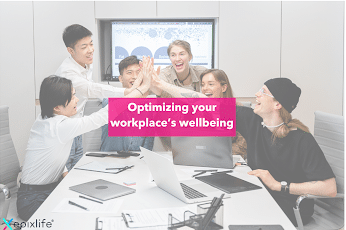Quality of life at work is critical to ensuring the well-being and success of both employees and the company.
Modern work environments present increasing challenges: high levels of stress, a fast pace, constant pressure, and often a heavy mental workload.
These factors affect productivity and increase the risk of sick leave. Adopting strategies that promote wellness can make a big difference in the quality of work life and employee performance.
Below, we will explore some of the most effective strategies for optimizing well-being in the work environment, with a focus on managing stress, promoting mental and physical health, and creating a balanced work environment.
The impact of work-related stress on employees
Stress is one of the leading causes of sick leave, and its prevalence has been increasing. According to recent data, stress-related sick leave has increased by 21% compared to previous years.
This indicates an urgent need to manage stress effectively and to create workplaces where employees can feel emotionally balanced and mentally supported.
Causes of stress in the work environment
Multiple factors contribute to stress at work, such as excessive workload, high expectations, lack of support, pressure for results, and in, many cases, internal competition.
These elements not only affect mental health but also impact physical health and the worker’s ability to stay focused and productive.
Consequences of not addressing stress
When stress is not managed, employees can experience a range of problems, including difficulty concentrating, mental exhaustion, sleep disturbances, and even a weakened immune system.
These effects impact not only the individual but also the overall performance of the team and the company. It is therefore essential to implement preventive strategies to prevent stress from becoming chronic.
Strategies to improve mental wellbeing at work
Improving mental well-being in the workplace is a priority. Employees need to feel supported and have tools to help them manage their emotions and stress. Some of the most effective strategies include practices such as meditation, mindfulness, and resilience training.
Mindfulness and conscious breathing practices
Mindfulness and conscious breathing techniques are simple and accessible tools for everyone and offer great benefits for reducing stress at the moment. These practices promote concentration on the present and help release accumulated tensions, allowing employees to feel calmer and more focused.
Promoting resilience in the team
Fostering resilience is a key strategy for facing challenges and adapting to adverse situations. Training employees in resilience helps them to maintain a positive attitude in the face of change and difficulties. This can be done through workshops and group sessions that strengthen emotional responsiveness to work challenges.
The importance of a balanced diet for work performance
Nutrition is a fundamental aspect of wellness, as it directly impacts people’s energy, concentration, and stamina. In the workplace, offering healthy food choices is an excellent way to ensure that employees maintain their energy levels and well-being throughout the day.
Healthy eating options in your workplace
Including fresh and varied foods, such as fruits, vegetables, and protein sources, it is critical to maintain a balanced diet. Avoiding ultra-processed foods and sugary drinks at the workplace is key to maintaining stable energy levels and reducing fatigue.
Physical activity to counteract a sedentary work environment
Sedentary lifestyles are a common problem in many workplaces, especially those that require long hours in front of a screen. Physical activity helps counteract the effects of a sedentary lifestyle, improves circulation and metabolism, and reduces mental fatigue.
Strategies to promote physical activity at work
Encouraging movement throughout the day is an excellent way to take care of employees’ physical and mental well-being. Active breaks, stretching, short walks, or even short exercise classes during the workday can have a positive impact on mood and productivity.
Measures to reduce exposure to electromagnetic fields
Technology plays a crucial role in the modern work environment, but it also carries certain risks. Prolonged exposure to electromagnetic fields (EMF) can affect the well-being of some employees, especially those who are more sensitive to these radiations. Reducing this exposure is one way to create a healthier environment and reduce the possibility of stress and fatigue.
Reducing EMFs in the workplace
Some recommendations include: turning off devices when not in use, increasing ventilation in the workspace, taking advantage of natural sunlight, and keeping break areas free of electronic devices. These types of measures can help employees feel more comfortable and relaxed in their workspace.
Conclusion
Optimizing wellness in the work environment is an investment in employee well-being and productivity. Implementing strategies that promote stress management, physical activity, healthy eating, and reduced exposure to risk factors can transform the work experience and contribute to a more engaged and efficient team.

